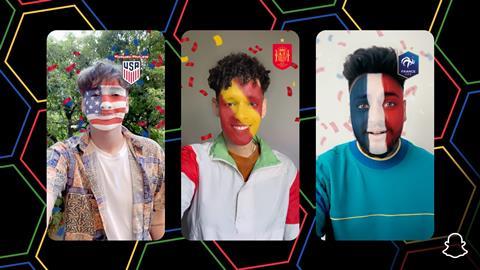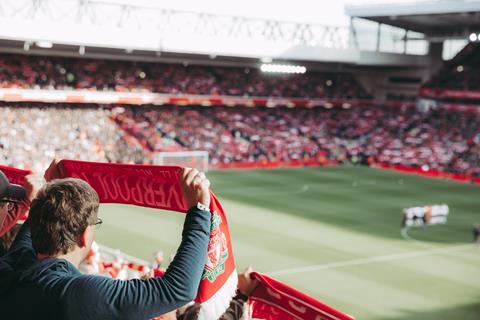Snap’s senior manager of international sports partnerships, Kahlen Macaulay, reveals why a mix of tech, celebrity stardust and access-all-areas experiences could be key

What was the must-see, hot sporting ticket of 2023? The FIFA Women’s World Cup, the Rugby World Cup in France, Djokovic’s record breaking 23rd Major in men’s tennis, or the inaugural F1 race in Las Vegas, perhaps?
Sports fandom is, of course, highly subjective. Passionate followers of rugby may be left cold by rowing, while Manchester United fans wouldn’t be seen dead at the Etihad for anything other than derby day.
And yet, sporting events, organisations and teams can – and must – evolve to attract new fans every day. Often, marquee events such as the women’s football or men’s rugby World Cups are the catalysts that can trigger a life-long passion, and 2024 is shaping up to be a vintage year for sport. From the UEFA European Championships to the Paris Olympic and Paralympic Games, there will be plenty of opportunities to inspire – and not just the existing or next generation of fans.
If sports properties and the brands invested with them are to make the most of the opportunities these unique moments present, they have to adopt a multifaceted and inclusive approach that speaks to and serves a broad set of ‘fans’ on their terms. Just existing isn’t enough any more.
First is curating the experience. The stadiums are just the start. You only need to look at the hype and entertainment around any F1 race, the ‘heat on the feet’ of NBA stars or the cultural hype of the SuperBowl in the US to understand that the sports experience is broader than the action on the pitch.
We saw that recently when the Taylor Swift phenomenon swept through the NFL as her considerable fan army collided with her new boyfriend, Kansas City Chiefs player Travis Kelce. His value as a sports brand shot up an estimated $5m almost overnight – sales of his jersey rocketed 400% as the Swift/Kelce pairing became 2023’s hot Halloween look.

Most of that content turned up on social media and fan ‘collateral’ – from shareable news, gossip and memes to interactive apps and dedicated emojis. Entertainment comes in many guises and today all of this has become part of the sport and fan experience. Sport must continue to be shaped and inspired by the entertainment industry if it is to compete for people’s attention.
For 2024 we anticipate further blending of sports and popular culture, as well as a blend of the physical and digital spaces when it comes to the fan experience. From immersive, rich experiences such as augmented reality, to deepened mobile engagement driven by accelerated personalisation from technology like AI and other web 3.0 tools, I expect the experience (not just sports) to be elevated closer to the high expectations of the next generation of fans. This is particularly critical in the context of attendance of live sports.
The launch of the Sphere in Las Vegas in 2023, a whole new level of expectation of what the live experience can be has been set. The Sphere remains unique but through connectivity in stadiums and effective use of data, with personalisation at its core, queues for food and drinks should be a thing of the past. The experience will be more in tune with an individual’s needs. Imagine if when arriving at the stadium, you were informed that you could purchase your favourite player’s jersey with 20% off if you bought it in the online stadium shop as a welcome to the game and a thank you for coming. And that it would be delivered to your seat, when you got there. And as a result of that purchase you now could get a further 10% off any additional purchases in the store that day.
The ability for AI to serve all this, through scaled use of data, will drive the personalisation of fan experiences to new levels and unlock incredible opportunities - be it in the stadium, at home, or through your phone - any time you’re consuming or interacting with sports.
Digital technology and mobile in particular brings fans closer to the sports experience in more ways than just interactivity and convenience, unlocking a whole raft of new opportunities that will only continue to evolve and mature. Just think about the impact AI has had with the launch of ChatGPT in 2023 alone and the value it is creating. For sporting brands that want to capitalise and grow their customer base, affinity and spend, they have more ways than ever to make fans feel part of their community. Leveraging technology will be critical to this, but bringing audiences closer to the action and in particular the sports stars, be it traditional athletes or ‘influencers’, offers a major point of differentiation.
There remains significant value to be realised by brands, sports organisations and platforms - connectivity, access, entertainment and more. Live sport still remains a strong bastion of real-time engagement, providing brands unique opportunities to differentiate and create value for fans watching in stadiums, on screens or at venues.
At the heart of the fan experience across 2024 is going to be a stronger sense of community. A sense of being able to participate in the experience and share it with others. But communities can be isolating, a clique that can reinforce the ‘them and us’. The sports properties, events and organisations that will have the most success are those that are able to broaden their potential ‘community’ by inviting anyone who wants to participate to join without judgement, taking them there and making them care.
In 2024, the Euros and Olympic and Paralympic Games are more than just sporting moments. They are cultural moments that matter, starting long before and continuing long after the final whistle has been blown.

Kahlen Macaulay is senior manager of international sports partnerships at Snap.




No comments yet